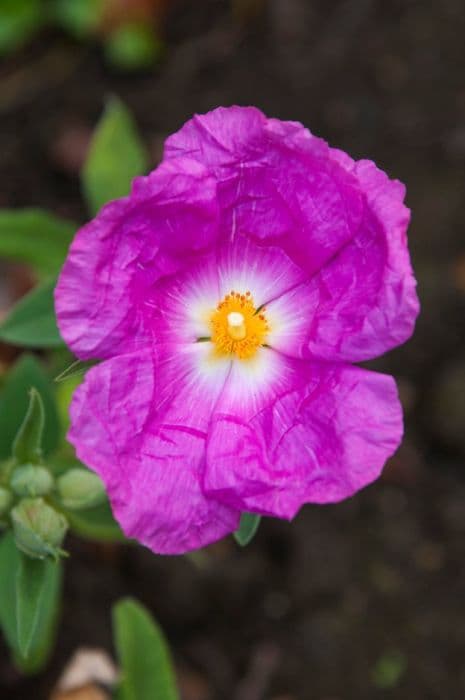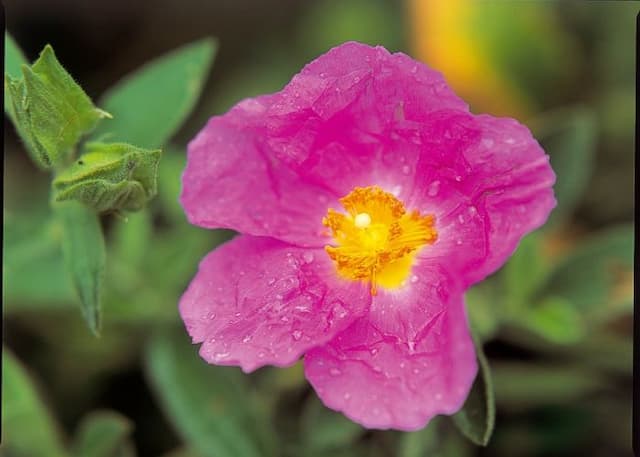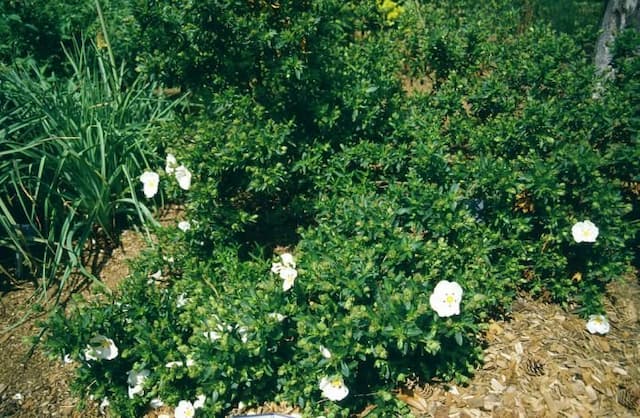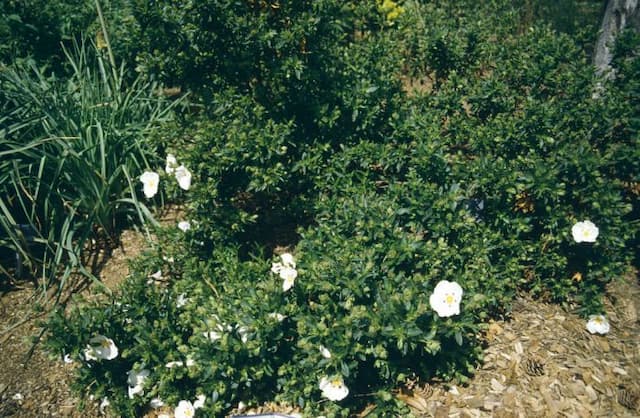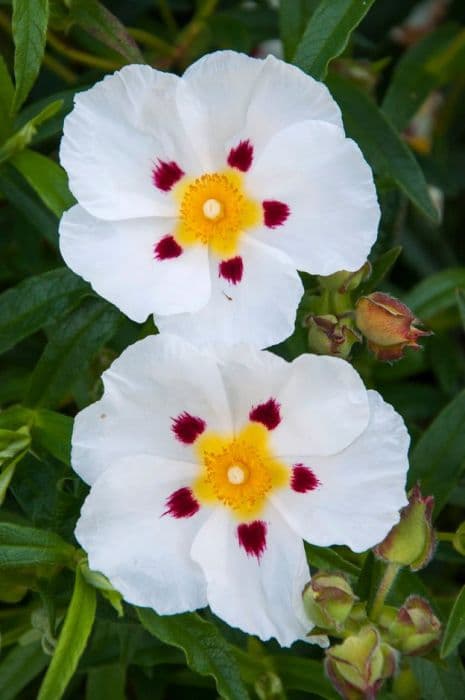Rock rose Cistus × heterocalyx 'Chelsea Bonnet'

ABOUT
'Chelsea Bonnet' is a perennial shrub known for its ornamental value in gardens. It has a dense, bushy habit, sprouting numerous stems that create a rounded shape. The foliage is composed of oval-shaped, slightly wrinkled leaves that are a dark green in hue, giving it a lush, textured appearance throughout the year. Most strikingly, 'Chelsea Bonnet' is celebrated for its abundant blooms. The flowers are large and showy, with five petals that are usually crinkled, resembling crepe paper. These blooms are a radiant white, often sporting a base that is punctuated with a symphony of yellow stamens at the center, which adds contrast and visual interest. The blossoms exude a subtle, pleasing fragrance, which can attract various pollinators to the garden. 'Chelsea Bonnet' has a generous flowering period that extends from late spring into the summer, providing a long-lasting display of color. As the flowers fade, they are often followed by the formation of small, woody capsules that contain the seeds. 'Chelsea Bonnet' presents a rustic and wild charm to any landscape, making it a popular choice for those seeking to add a touch of Mediterranean flair to their surroundings. Its drought-tolerant nature and ability to thrive in poor soils contribute to its popularity among gardeners looking for a low-maintenance, yet aesthetically pleasing, plant option.
About this plant
 Names
NamesFamily
Cistaceae
Synonyms
Rock Rose, Sun Rose
Common names
Cistus × heterocalyx 'Chelsea Bonnet'.
 Toxicity
ToxicityTo humans
Cistus, commonly known as rockrose, is generally considered non-toxic to humans. Therefore, ingestion of rockrose is not expected to cause significant symptoms of poisoning. However, it's always prudent to avoid eating plants that are not specifically grown for consumption to prevent any unexpected allergic reactions or gastrointestinal discomfort.
To pets
Rockrose is not known to be toxic to pets. If a pet ingests part of a rockrose plant, it is unlikely to experience poisoning symptoms. Nonetheless, ingestion of non-food plants can sometimes result in mild gastrointestinal upset in pets, such as vomiting or diarrhea, due to the irritation of the stomach or intestines. It's always best to keep an eye on pets around plants and to consult a veterinarian if any adverse reactions are observed after ingestion.
 Characteristics
CharacteristicsLife cycle
Perennials
Foliage type
Evergreen
Color of leaves
Green
Flower color
White
Height
3 feet [0.91 meters]
Spread
5 feet [1.52 meters]
Plant type
Shrub
Hardiness zones
8
Native area
Mediterranean
Benefits
 General Benefits
General Benefits- Attracts Pollinators: The plant produces flowers that attract bees, butterflies, and other beneficial pollinators to the garden.
- Drought Tolerance: Once established, Cistus × heterocalyx 'Chelsea Bonnet', commonly known as Rock Rose, is extremely drought-tolerant, making it suitable for dry climate gardens.
- Low Maintenance: Rock Rose generally requires minimal care, thriving in poor soils and needing little water or fertilization.
- Landscape Aesthetics: With its showy flowers and evergreen foliage, it contributes to the visual appeal of the landscape.
- Erosion Control: The plant's dense growth habit can help prevent soil erosion on slopes and banks.
- Deer Resistant: Rock Rose is often resistant to deer, making it a good choice for gardens in areas with deer populations.
- Fast Growth: It is known for its quick growth, providing rapid ground cover and visual interest in new gardens.
 Medical Properties
Medical PropertiesThis plant is not used for medical purposes.
 Air-purifying Qualities
Air-purifying QualitiesThis plant is not specifically known for air purifying qualities.
 Other Uses
Other Uses- Eco-printing: Cistus × heterocalyx 'Chelsea Bonnet' leaves can be used in eco-printing to transfer their shape and pigment to fabrics, creating natural patterns and designs.
- Plant dye: The flowers and leaves can be processed to create a natural dye for textiles, offering an eco-friendly alternative to synthetic dyes.
- Floral arrangements: Fresh or dried, the blooms of this plant can be included in floral arrangements for their delicate appearance and texture.
- Garden design: The plant can be used in xeriscaping, which is a landscaping method that reduces or eliminates the need for supplemental water from irrigation.
- Handmade paper: Incorporating the petals or small leaves into homemade paper can give a unique texture and appearance to the final product.
- Scented sachets: Dried petals can be enclosed in small pouches to create naturally fragrant sachets for drawers and wardrobes.
- Natural confetti: Dried petals of the cistus plant can serve as biodegradable confetti for eco-friendly celebrations.
- Photography: This plant with its beautiful blooms makes for an excellent subject in nature photography and can be used to demonstrate concepts like the golden ratio in nature.
- Sound barrier: When planted densely, cistus shrubs can serve as a natural sound barrier, helping to reduce noise pollution in gardens located near busy areas.
- Bee gardening: This plant is attractive to bees and other pollinators, making it an excellent choice for those looking to support local ecosystems and enhance biodiversity in gardens.
Interesting Facts
 Feng Shui
Feng ShuiThe Rockrose is not used in Feng Shui practice.
 Zodiac Sign Compitability
Zodiac Sign CompitabilityThe Rockrose is not used in astrology practice.
 Plant Symbolism
Plant Symbolism- Resilience: Cistus, or rockrose, often grows in dry, stony soil, symbolizing the ability to thrive in challenging conditions.
- Beauty: With its showy flowers, the rockrose is seen as a symbol of natural beauty, often gracing Mediterranean landscapes.
- Healing: Some species of Cistus are used in herbal medicine, symbolizing healing and the rejuvenating power of nature.
- Protection: The resin of certain Cistus species, known as labdanum, is thought to have protective qualities, and it's used in perfumery and in traditional medicine as a safeguard against ailments.
 Water
WaterRockrose plants, like Cistus 'Chelsea Bonnet', require moderate watering. During the growing season in spring and summer, water the rockrose thoroughly, allowing the soil to dry out slightly between waterings. This could equate to approximately 1 inch of water every week, depending on local climate conditions. However, it's important to reduce watering frequency in the fall and further during the winter, when the plant is dormant, to prevent overwatering and root rot. As a guideline, during the dormant season, cut back to watering once every two to three weeks with just enough water to prevent the soil from completely drying out.
 Light
LightRockrose, such as Cistus 'Chelsea Bonnet', thrives in full sun. It should be positioned in a spot where it can receive at least six hours of direct sunlight daily. This plant is adapted to bright conditions and the full sun exposure will help ensure abundant flowering and healthy growth.
 Temperature
TemperatureRockrose, including Cistus 'Chelsea Bonnet', prefers a temperate climate and does well in temperatures between 50°F and 80°F. It can tolerate a minimum temperature down to around 20°F, but it's important to protect it from frost. The ideal temperature range allows the rockrose to flourish, ensuring it can endure hot summers and cooler winters without stress.
 Pruning
PruningPruning is important for maintaining the shape and health of Cistus 'Chelsea Bonnet', or rockrose. Light pruning should be done after flowering, typically in late spring or early summer, to remove spent flowers and encourage a dense growth habit. Significant pruning to shape the plant or reduce its size should be done with care, as the rockrose does not respond well to heavy cutting back.
 Cleaning
CleaningAs needed
 Soil
SoilRockrose 'Chelsea Bonnet' thrives in well-draining soil with a mix of sand, peat, and loamy components to foster drainage and mimic its native Mediterranean habitat. A slightly acidic to neutral pH range of 6.0 to 7.5 is ideal for its growth.
 Repotting
RepottingRockrose 'Chelsea Bonnet' does not require frequent repotting; it may be repotted every 2-3 years or as necessary if it outgrows its container or the soil becomes exhausted.
 Humidity & Misting
Humidity & MistingRockrose 'Chelsea Bonnet' prefers a low to moderate humidity level, typical of Mediterranean climates, and is tolerant of dry conditions.
 Suitable locations
Suitable locationsIndoor
Place in bright light, well-drained soil, dry air.
Outdoor
Full sun, well-draining soil, protect from severe frost.
Hardiness zone
8-11 USDA
 Life cycle
Life cycleThe plant commonly known as Cistus 'Chelsea Bonnet' begins its life as a seed, which germinates in well-draining soil under full sunlight. After germination, the seedling stage involves the development of a root system and the emergence of cotyledons, before true leaves develop and photosynthesis begins. As the plant enters the vegetative stage, it experiences rapid growth, producing foliage and branches in preparation for reproduction. The reproductive stage is marked by the flowering of 'Chelsea Bonnet', where large pink to purplish flowers bloom, attracting pollinators for sexual reproduction. After pollination and fertilization occur, seeds develop within fruits, which eventually disperse to initiate a new life cycle. In some conditions, 'Chelsea Bonnet' may also reproduce vegetatively, where cuttings can root and grow into mature plants, bypassing the seed stage.
 Propogation
PropogationPropogation time
Spring-Early Summer
Propogation: The Rock Rose 'Chelsea Bonnet' can be propagated through semi-hardwood cuttings, which is the most popular method for this shrub. This process generally takes place during the summer months, once the spring growth has matured enough to have slightly hardened but is still flexible. Cuttings should be taken from the current year's growth, ideally from non-flowering shoots, to ensure the best chance of rooting. Cut a stem of about 4 to 6 inches (10 to 15 centimeters) long, remove the lower leaves, and dip the cut end into rooting hormone to encourage root development. Then, plant the cutting in a well-draining soil mix and maintain consistent moisture without waterlogging. Providing a humid environment with partial shade can help improve success rates, and roots typically develop within a few weeks at which point the new plants can gradually be acclimatized to more direct sunlight.
